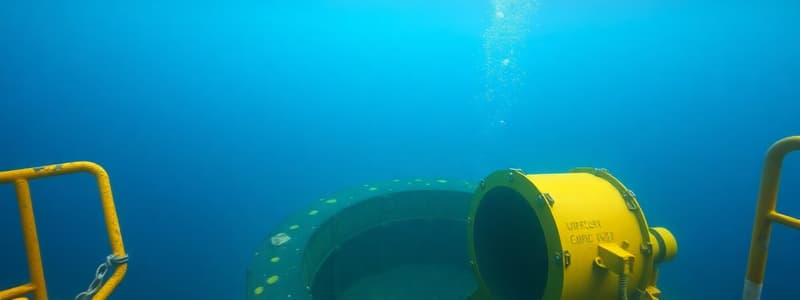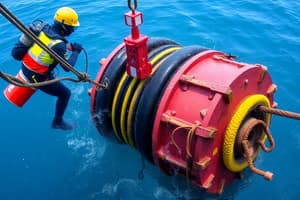Podcast
Questions and Answers
What critical factor contributed to the crane hook striking the diver's helmet during the subsea spool tie-in operations?
What critical factor contributed to the crane hook striking the diver's helmet during the subsea spool tie-in operations?
- The diver's failure to properly secure their helmet.
- The diving supervisor's decision to proceed without a pre-dive briefing.
- A sudden and unexpected shift in the seabed's structure.
- Inadequate length of the crane pennant/stinger, reducing the distance between the divers and crane hook. (correct)
In the described incident, what led the crane operator to believe the crane hook had reached the seabed?
In the described incident, what led the crane operator to believe the crane hook had reached the seabed?
- The diving supervisor's explicit verbal confirmation.
- Direct visual confirmation from underwater cameras.
- A 'no weight' reading on the crane wire after the hook rested on the PHF. (correct)
- The activation of a proximity sensor installed on the seabed.
Besides ensuring adequate distance, what other proactive measure is recommended to prevent similar incidents in subsea operations with poor visibility?
Besides ensuring adequate distance, what other proactive measure is recommended to prevent similar incidents in subsea operations with poor visibility?
- Minimizing communication to reduce potential misunderstandings.
- Employing alternative methods such as underwater cameras or sonar to track equipment position. (correct)
- Implementing mandatory overtime for dive teams to enhance focus.
- Using exclusively manual tools to reduce equipment failure risks.
What immediate action demonstrated effective emergency response after the diver's helmet was struck?
What immediate action demonstrated effective emergency response after the diver's helmet was struck?
Beyond the immediate response, what procedural update was implemented to prevent recurrence of similar incidents?
Beyond the immediate response, what procedural update was implemented to prevent recurrence of similar incidents?
Flashcards
Cause of diving incident?
Cause of diving incident?
During subsea operations, a crane hook struck a diver's helmet due to misjudgment of its position.
Safe crane pennant length
Safe crane pennant length
The length of the crane pennant should ensure safe distance between divers and the crane hook to prevent accidental contact, especially in low visibility.
Enhanced visibility aids
Enhanced visibility aids
Using underwater cameras or sonar to better track the position of critical equipment in poor visibility environments.
Importance of communication
Importance of communication
Signup and view all the flashcards
Updated safety measures
Updated safety measures
Signup and view all the flashcards
Study Notes
- During subsea spool tie-in operations, a diver's helmet was struck by a crane hook.
- The incident occurred on 6 March 2025
What Happened
- Divers were working on the seabed in poor visibility during subsea spool tie-in operations.
- After landing the pipe handling frame (PHF), the Diving Supervisor instructed the crane operator to lower the crane hook.
- The crane operator reported 'no weight' on the crane wire, leading the Diving Supervisor to assume the hook had reached the seabed.
- The diver proceeded to disconnect the PHF from the crane.
- The crane hook unexpectedly struck the diver's helmet.
- The diver returned to the dive bell unharmed, and the dive was aborted.
- The diver's helmet was irreparably damaged, including the side block.
- The helmet's integrity was maintained.
What Went Right
- Diver 2 promptly assisted Diver 1, and both divers returned to the bell safely.
- Both divers and the crane block had locating beacons for accurate tracking.
- All procedures, lifting plans, and Job Hazard Analysis (JHA's) were followed.
- The diver was uninjured because the helmet absorbed the impact.
What Went Wrong
- The crane hook came to rest on the top beam of the PHF, resulting in a 'no weight' reading.
- The crane operator assumed the hook had reached the seabed.
- When the diver approached the disconnection point, the hook slipped off the beam and struck the diver's helmet.
What Was the Cause
- Inadequate length of crane pennant / stinger did not provide sufficient distance.
- Poor visibility hindered the ability to observe the crane hook's position.
Lessons and Actions
- Ensure adequate distance between divers and the crane hook.
- The length of the crane pennant/stinger should be sufficient to maintain a safe distance.
- This reduces the risk of accidental contact.
- Enhance visibility aids and monitoring.
- Use alternative methods like additional locating beacons, underwater cameras, or sonar.
- Improved monitoring can help prevent misjudgments.
- Reinforce communications, challenge assumptions!
- Minimize assumptions regarding equipment position.
- Clear communication and confirmation procedures should be reinforced.
- This ensures all parties are fully aware of the equipment's location.
Additional Actions
- Project procedures were updated.
- This specifies minimum pennant lengths for different operations.
- Pre-operation inspections of all rigging and lifting equipment were conducted.
- This includes crane hooks and pennants, to ensure they meet safety standards.
- The Job Hazard Analysis (JHA) was updated.
- It incorporates lessons learned regarding safe distances, visibility, and communication requirements for subsea lifting operations.
Studying That Suits You
Use AI to generate personalized quizzes and flashcards to suit your learning preferences.




